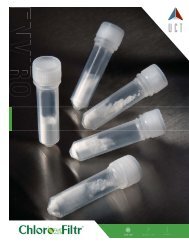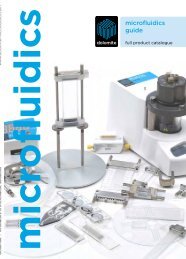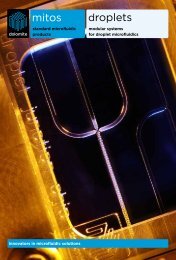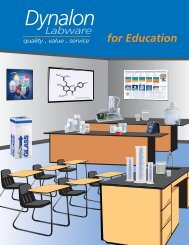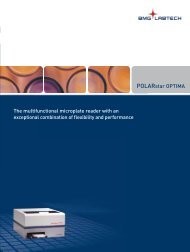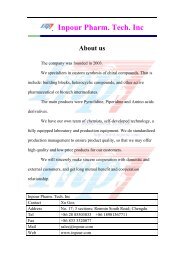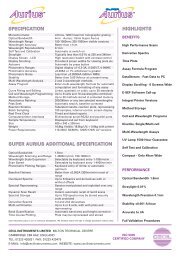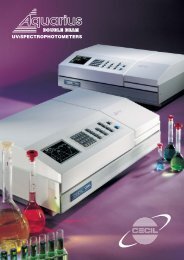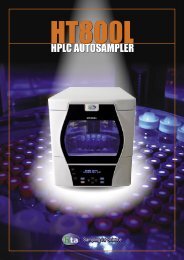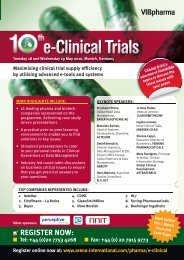temporospatial
Thermo-reversible mountant for LIVE cells - Labhoo.com
Thermo-reversible mountant for LIVE cells - Labhoo.com
- No tags were found...
Create successful ePaper yourself
Turn your PDF publications into a flip-book with our unique Google optimized e-Paper software.
New strategies for suspension cell-basedimaging assays in HCSRoy EDWARD & Stefan OGRODZINSKIBiostatus Ltd, 56 Charnwood Road, Shepshed, Leicestershire, LE12 9NP, UKIntroductionImaging-based assays have primarily relied uponadherent cell types for <strong>temporospatial</strong>measurements. This limits choice of cell type andextension of detection technologies to relevantbiological models that may comprise nonadherent(e.g. suspension culture) or indeed‘detaching’ (e.g. loss of viability/adherence) cellstates such as drug candidate screening inimmunological and lymphoproliferative disordermodels, where the therapeutic target is oftenpresented by a non-adherent type cell or where abiological response requires changes inadherence to a substrate. New technologies arethus needed to deal with live cell-based HCSassays on non-adherent cells or to exploitsuspension cells in fluidic systems.Here we describe CyGEL - a thermo-reversiblehydrogel-based 4-D immobilization technology forlive cell location without imposing an anchoringto a substrate.Figure 1: Chilled CyGELdispensed onto microscopeslide and coverslip overlaid.Re-chilling the gel allows itto spread evenly.Figure 2: GFP expressingcells mounted in DRAQ5dopedCyGEL. DRAQ5far-red emitting live cellnuclear counterstain.Figure 3: CyGEL is compatible with live cells. Adherent cells wereimaged before and 10 and 30 min.after being overlaid with CyGEL.GFP-expressing cellsGFP-expressing cellsGFP-expressing cellsIn mediumIn CyGEL at 10 min In CyGEL at 60 minKey benefits of CyGEL for HCS in livenon-adherent cells/organisms• Rapid preparation of live cells for gel mounting• Long term analysis of non-adherent cells• Support matrix, distinct from vessel surface• Sterile, low temp recovery of viable cells from gel• Multiple assay formats & applications e.g.apoptosisTechnological FeaturesTHERMO-REVERSIBLE:CyGEL is a liquid when cooled and rapidly gelsabove 21°C. Live cells are mixed with cooledCyGEL, warmed to hold them for imaging. Cellscan be recovered for further analysis e.g. RT-PCRby re-cooling.OPTICALLY INERT & COMPATIBLE WITHFLUORESCENCE:CyGEL is optically clear and inert with low auto-fluorescence (fig.1). CyGEL has a refractive indexof 1.365 at 37°C (100% strength, as supplied)similar to water (1.33). Fig.2 demonstrates itscompatability with fluorophores.COMPATIBLE WITH LIVE CELLS:Cells retain viability and morphology while proteinexpression is unperturbed (Fig. 3). HeLa cells heldin CyGEL for up to 4 hours retained viability andentered apotosis in the expected manner (Upton,2007).IMMOBILIZES CELLS & BEADS TEMPOROSPATIALLY:Allows calibration using beads, and <strong>temporospatial</strong>and high resolution imaging of live cellsheld in space over time (see fig 4.).
Figure 4: Red fluorescent beads in buffer (top series) and in CyGEL(bottom) imaged at t = 0 sec., 1 sec., 2 sec., 3 sec. and a composite. Inthe composite, white events have not moved, coloured events havemoved from frame to frame. The top image used one bead as a point ofreference (the remaining one in white in the top-right hand panel).1 µm red fluorescent beads in buffer1 µm red fluorescent beads in CyGEL0 sec 1 sec 2 sec 3 sec 4-mergeFigure 5: Live CalceinAM-labeled cellsmounted in CyGELFigure 6: PI –doped CyGELcontaining apoptosinglymphoma cellsApplication ExamplesCELL REPORTER ASSAYS:CyGEL Clear used to mount cells with internalfluorescent signals (e.g. GFP) or functional probes(e.g.calcein labeled cells, as in fig. 5).APOPTOSIS ASSAYS:CyGEL were doped with 1 µM Propidium Iodide(PI) used to observe Apoptosis over time. Fig. 6shows a composite image of lymphoma cells takingup PI as they become leaky.COUNTERSTAIN-LOCALIZED CELLS:CyGEL doped with a nuclear counterstain (e.g.DRAQ5 stained cells, as in fig. 7) suitable for cellcycle position, trans-locations and end-point(antibody-tagged) measurements.Cell Imaging PreparationMacropad method: Cells and CyGEL premixed then depositedDelivery lance depositingCyGEL/cell mixat 4-8 °CDelivery lance depositing CyGELat 4-8 °C to prepare a MacroPadFigure 9: Live C. elegansimaged in levamisoledopedCyGEL.Macro padspreadsduring chillingMicrodroplet method: Cell droplet injected into CyGELDelivery lance depositingconcentrated cell suspensionat 4-8 °C into base of macropad•Macro pad thin film sets atroom temp and traps cellsduring imaging•Mineral oil overlay may be usedChilling of plate causes microdropletaqueous phase to merge with CyGELand spread against optical surface asthe macropad collapsesWhole live organism immobilizationN.B. both of thesemethods can be used inmicroplate wells orconverted to microarrays.Early experience suggests thatCyGEL has considerable utilitywhen imaging live (and fixed)multicellular and protozoanorganisms and that theseorganisms can be rescuedviable from the gel for furtherstudies.Warming of plate toroom temp forms gelready for imagingFigure 7: Live cellnuclei imaged in20µM DRAQ5dopedCyGEL.Figure 8: DRAQ5 (20 µM) staining kinetics forindividual live tumour cell nuclei imaged inPBS and CyGEL. The range of steady-stateintensity reflects cell cycle position.CONTROLLED DELIVERY OF FLUOROCHROMES /DRUGS: kinetics of delivery of small molecules ismodified in CyGEL, where the gel acts as areservoir. The kinetics of DRAQ5 staining cells inPBS and CyGEL is compared in fig. 8.Figure 10: Fixed D. rerioshowing tail vesseldevelopment 5dpf –vascular endothelial cellsexpressing GFP-Fli-1.Mounted in CyGEL.Correcte d Inte grated intensity6.00E+065.00E+06in PBSin CyGEL4.00E+063.00E+062.00E+06Conclusions / Future Work1.00E+060.00E+0000:00 00:14 00:28 00:43 00:57 01:12 01:26enquiry@biostatus.comA biologically-compatible mountant, CyGEL hasadvantageous optical properties for fluorescenceimaging and tunable physical properties for gel-soltransition and molecular probe delivery as part ofHCS protocols. It can support culture mediaadditives (i.e. CyGEL Sustain), cell-permeant dyes,and other small molecules.Future work will include:a) specific methodologies for parasites (e.g.trypanosoma, leishmania, plasmodium sp.) andwhole organism screening: D. rerio, C. elegansb) Ready-to-use MTP-format CyGEL for higherthroughput applicationsSupported in part by UK Biotechnology and Biological Sciences Research Council [SBRI grant19666]. Biostatus Ltd would like to acknowledge the collaboration with the Optical BiochipResearch consortium funded by Joint Research Councils UK




